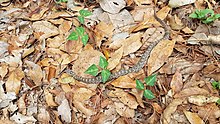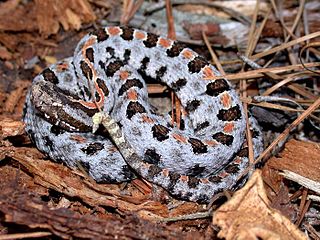
Sistrurus is a genus of venomous pit vipers in the subfamily Crotalinae of the family Viperidae. The genus is endemic to Canada, the United States, and Mexico. Its generic name is a Latinized form of the Greek word for "tail rattler" and shares its root with the ancient Egyptian musical instrument, the sistrum, a type of rattle. Three species are currently recognized.

Crotalus stephensi is a venomous pitviper species found in central and southern Nevada and adjacent California. Common names include panamint rattlesnake, panamint rattler, Owens Valley rattler, and tiger rattlesnake.

Cerrophidion is a genus of venomous pitvipers which are endemic to southern Mexico, Central America, and western Panama. The generic name, Cerrophidion, is derived from the Spanish word cerro, which means "mountain", and the Greek word ophidion, which means "small snake". Five species are currently recognized, but no subspecies.

Crotalus ravus, commonly known as the Mexican pigmy rattlesnake or Mexican pygmy rattlesnake, is a venomous pit viper species, found only in Mexico. Three subspecies are currently recognized.

Crotalus viridis nuntius is a venomous pit viper subspecies native primarily to the desert plateau of the northeastern portion of the American state of Arizona, but also ranges into northwestern New Mexico. Named for the Native American Hopi tribe, which inhabits the region, its range overlaps that of the nominate subspecies and some interbreeding is believed to occur. The taxonomy of the C. viridis group is a matter of debate, many considering the various subspecies to be nothing more than locality variations.
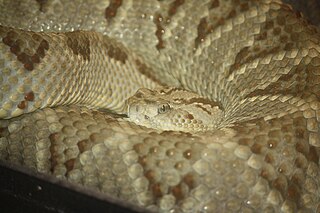
Crotalus simus is a venomous pit viper species found in Mexico and Central America. The specific epithet is Latin for "flat-nosed", likely because its head is blunt compared with lanceheads (Bothrops). Three subspecies are recognized, including the nominate subspecies described here.

Crotalus intermedius is a pit viper species found in central and southern Mexico. Like all other pit vipers, it is venomous. Three subspecies are currently recognized, including the nominate subspecies described here.
Crotalus intermedius omiltemanus is a venomous pitviper subspecies found in Mexico in the state of Guerrero.

Crotalus pricei is a species of venomous snake, a pit viper in the family Viperidae. The species is endemic to the southwestern United States and northern Mexico. Two subspecies are recognized.
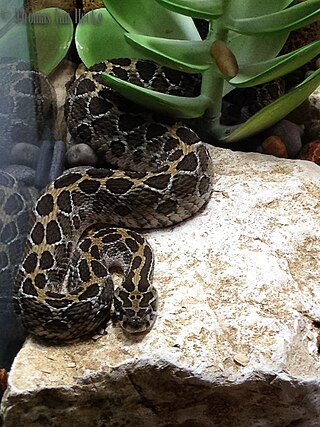
The Mexican lance-headed rattlesnake or lance-headed rattlesnake is a venomous pit viper species found in central Mexico. No subspecies is currently recognized.

Crotalus stejnegeri, commonly known as the Sinaloan long-tailed rattlesnake or just long-tailed rattlesnake, is a venomous pit viper species in the family Viperidae. The species is native to western Mexico. There are no recognized subspecies.

Crotalus transversus, or the Cross-banded Mountain Rattlesnake, is a venomous pit viper species found in central Mexico, known from less than 20 specimens. No subspecies are currently recognized.

Crotalus triseriatus is a venomous pit viper species found in Mexico. Two subspecies are currently recognized, including the nominate subspecies described here.

Crotalus cerastes cercobombus, commonly known as the Sonoran Desert sidewinder or Sonoran sidewinder, is a pitviper subspecies found in the eastern part of the Sonoran Desert in the southwestern United States and northwestern Mexico. Like all pitvipers, it is venomous. The subspecific epithet means buzzertail.
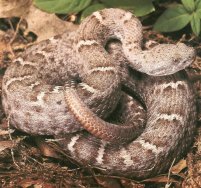
Crotalus willardi obscurus is a venomous pitviper subspecies found in northwestern Mexico and the Southwestern United States.
Crotalus totonacus is a venomous pit viper species found in northeastern Mexico. No subspecies are currently recognized.
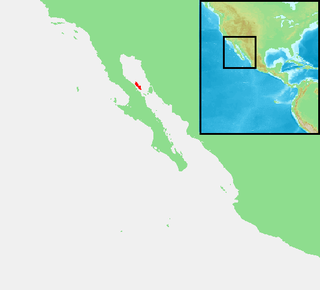
Crotalus angelensis, or the Ángel de la Guarda Island speckled rattlesnake, is a pitviper species endemic to Isla Ángel de la Guarda in the Gulf of California, Mexico. Like all other pitvipers, it is venomous. It is sometimes treated as a subspecies of Crotalus mitchellii.
Crotalus lorenzoensis, or the San Lorenzo Island Rattlesnake, is a species of pit viper.

Gloydius intermedius is a venomous pitviper species endemic to northern Asia. Three subspecies are currently recognized, including the nominate subspecies described here.
Crotalus ruber lucasensis is a venomous pitviper subspecies found in Mexico in the Cape region of lower Baja California.
